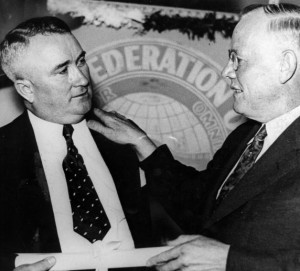Relationships with AFL and the CIO
The United Automobile Workers was chartered by the American Federation of Labor (AFL) on August 26, 1935, and appointed Francis Dillon its president. Originally known as the United Automobile Workers of America (UAWA), it was later shortened to UAW. The demands of the growing number of autoworkers could no longer be ignored by the AFL. The formation of the Automotive Industrial Workers Association at Chrysler’s Dodge Main plant, which boasted 24,000 members served as a huge boost to the growing legitimacy and clout of autoworkers in the labor movement. The growing schism between AFL and UAW leaders about the inclusion of unskilled laborers led to the UAW breaking with the AFL and joining with the CIO in May of the following year, and elected Homer Martin its new president. In its first years, the UAW helped lead many successful strikes including the Bendix Products strike, the Midland Steel strike (halting parts deliveries to Chrysler and Ford), as well as the Kelsey-Hayes Wheel strike, and the Flint Sit-Downs. In 1938, our current president RJ Thomas was elected. [1]

William Green, president of the American Federation of Labor (AFL) presents Francis Dillon with the international charter that establishes the United Automobile Workers of America, Detroit, Michigan.
(http://www.reuther.wayne.edu/node/4927)
Craft v. Industrial Unionism
The UAW was not originally an autonomous organization, but rather a probationary charter by the AFL, it’s officers and policies shaped by ALF president at that time. Most of the unions comprising the AFL were craft-based, each representing workers in a skilled trade–carpenters, machinists, electricians. All but a few, such as the United Mine Workers and the Amalgamated Clothing Workers, were industrial unions that sought to organize all of an industry’s workers regardless of the task each person performed. It was John L. Lewis, president of the United Mine Workers who took the opportunity offered by the Great Depression to bring the millions of factory hands in the core industries of auto, steel, agricultural, implements, rubber, electrical equipment, and chemicals into industrial unions, under a new body of labor called the CIO (Committee for Industrial Organization). Industrial workers inspired by a new vision of the “new deal” in the workplace as well as in politics, prepared to challenge the owners and managers of capital for control of their working lives.
Auto workers soon rebelled against the AFL’s inexperienced autoworker as their leader and in April of 1936 became a self-governing affiliate of the AFL. The union joined forces with other industrial unions in the CIO, which soon led to their expulsion from the AFL. [1]
